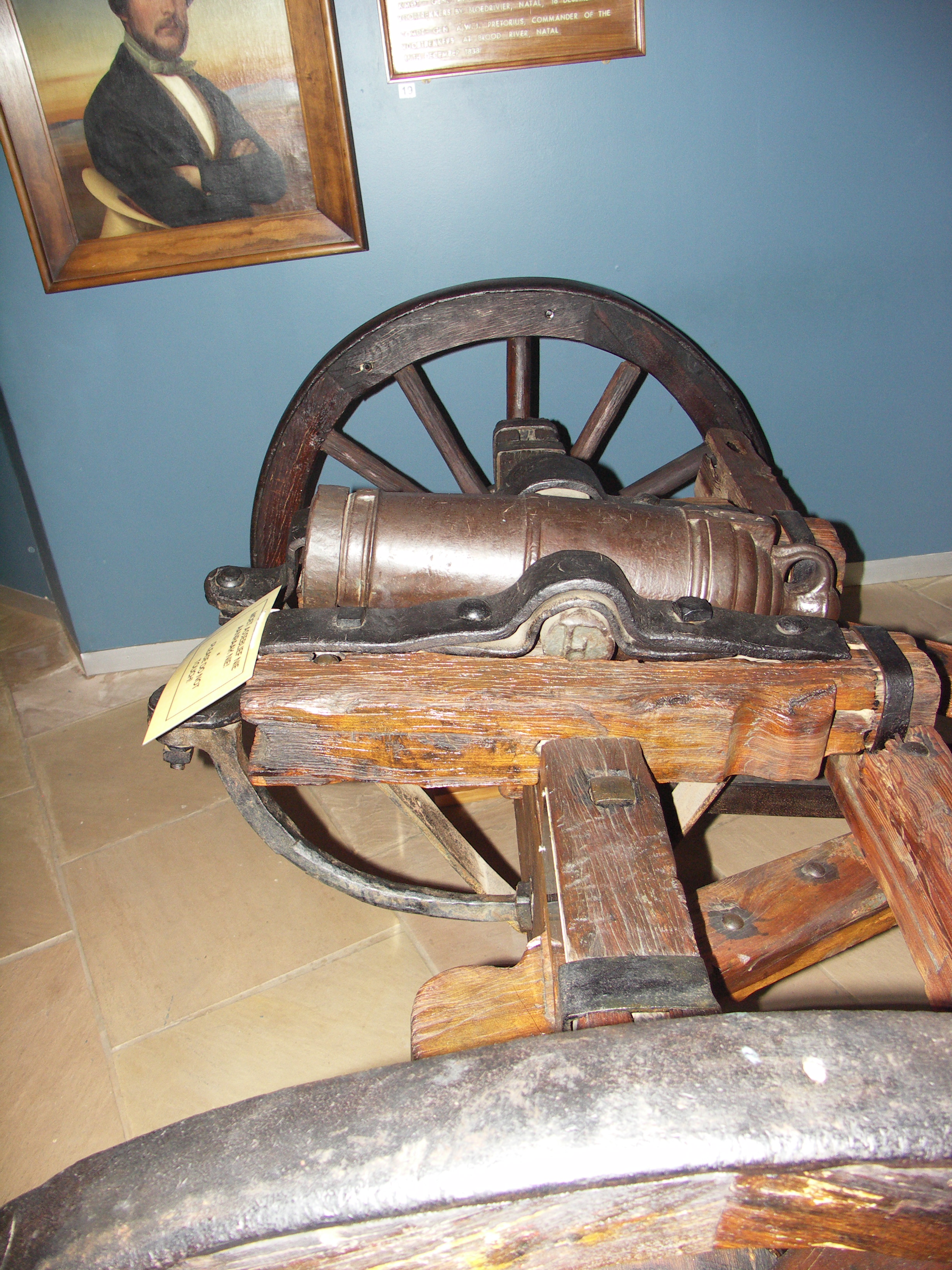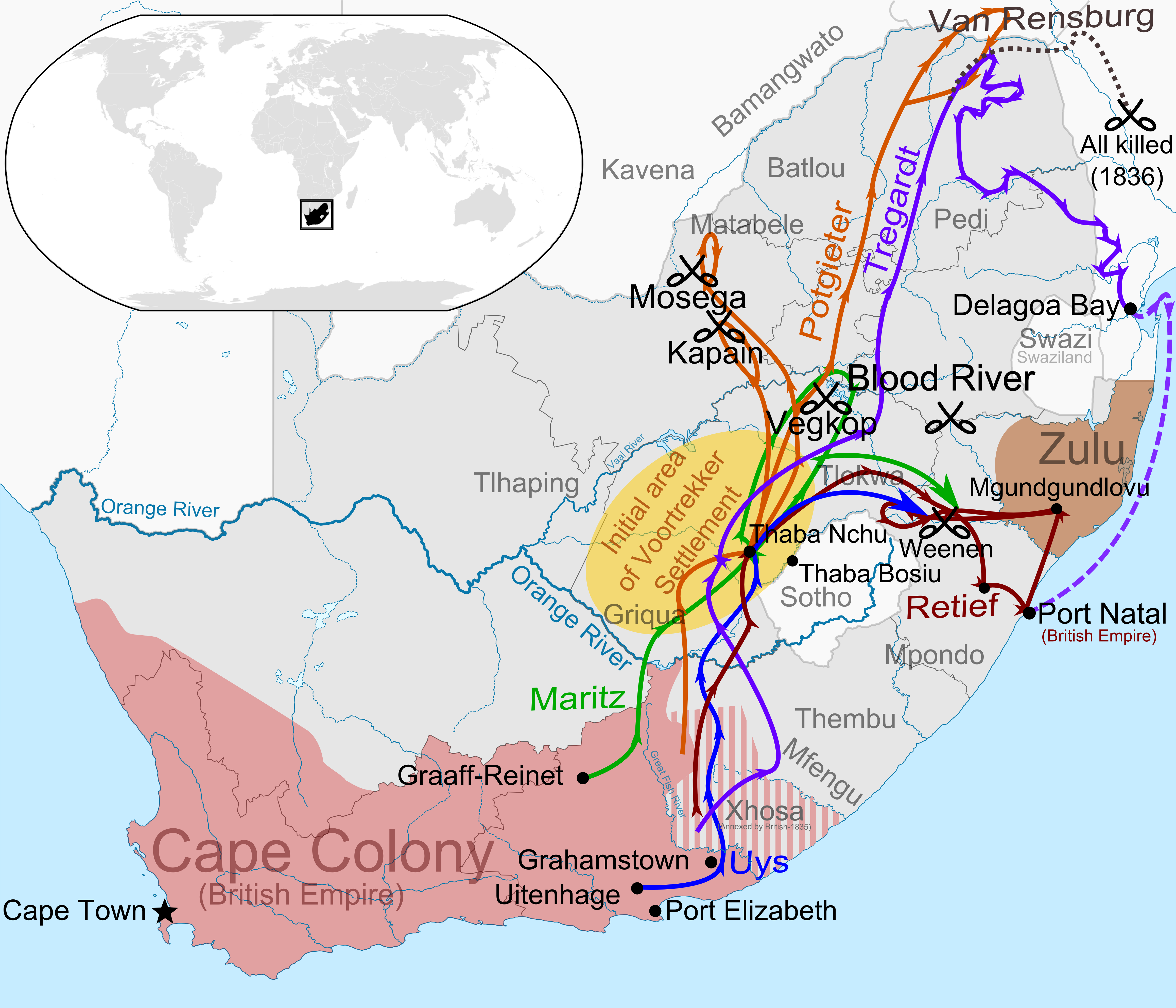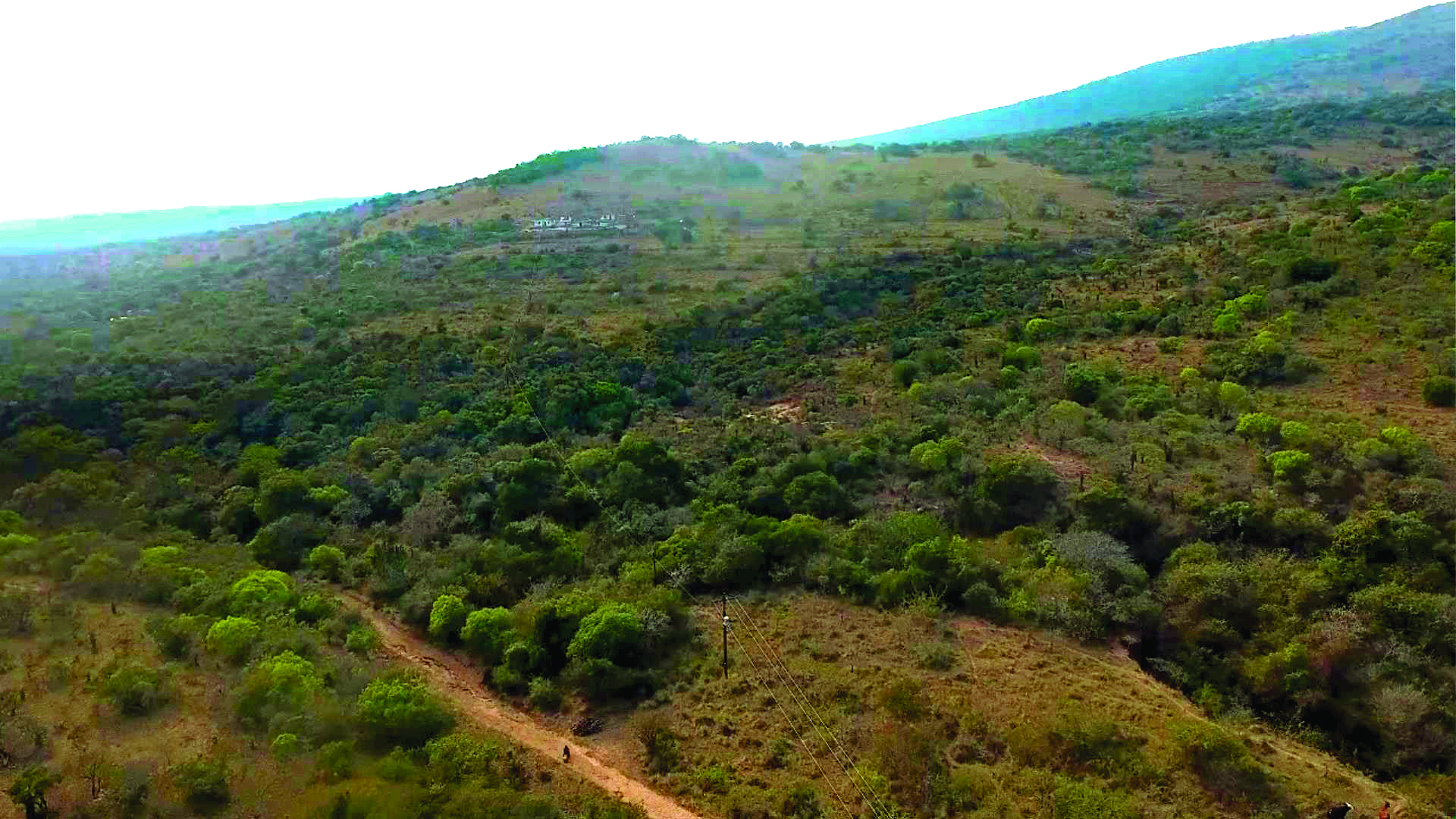|
Battle Of Blood River
The Battle of Blood River or Voortrekker-Zulu War (16 December 1838) was fought on the bank of the Blood River, Ncome River, in what is today KwaZulu-Natal, South Africa between 464 Voortrekkers ("Pioneers"), led by Andries Pretorius, and an estimated 25,000 to 30,000 Zulu Kingdom, Zulu. Estimations of casualties amounted to over 3,000 of King Dingane kaSenzangakhona, Dingane's soldiers dead, including two Zulu princes competing with Prince Mpande for the Zulu throne. Three Voortrekker commando members were lightly wounded, including Pretorius. The year 1838 was the most difficult period for the Voortrekkers from when they left the Cape Colony, till the end of the Great Trek. They faced many difficulties and much bloodshed before they found freedom and a safe homeland in their Republic of Natalia. This was only achieved after defeating the Zulu Kingdom, at the Battle of Blood River, which took place on Sunday 16 December 1838. This battle would not have taken place if the Zulu K ... [...More Info...] [...Related Items...] OR: [Wikipedia] [Google] [Baidu] |
Great Trek
The Great Trek (, ) was a northward migration of Dutch-speaking settlers who travelled by wagon trains from the Cape Colony into the interior of modern South Africa from 1836 onwards, seeking to live beyond the Cape's British colonial administration. The Great Trek resulted from the culmination of tensions between rural descendants of the Cape's original White South Africans, European settlers, known collectively as Boers, and the British Empire, British. It was also reflective of an increasingly common trend among individual Boer communities to pursue an isolationism, isolationist and semi-nomadic lifestyle away from the developing administrative complexities in Cape Town. Boers who took part in the Great Trek identified themselves as ''voortrekkers'', meaning "pioneers" or "pathfinders" in Dutch language, Dutch and Afrikaans language, Afrikaans. The Great Trek led directly to the founding of several autonomous Boer republics, namely the South African Republic (also known sim ... [...More Info...] [...Related Items...] OR: [Wikipedia] [Google] [Baidu] |
Piet Retief Delegation Massacre
The Piet Retief Delegation massacre was the 1838 killing of 100 Voortrekkers by the Zulu king Dingane in what is now KwaZulu-Natal, South Africa. The Voortrekkers, led by Piet Retief, migrated into Natal in 1837 and negotiated a land treaty in February 1838 with Dingane. Upon realizing the ramifications of the imposed contract, Dingane betrayed the Voortrekkers, killing the delegation including Retief on 6 February 1838. The land treaty was later found in Retief's possession. It gave the Voortrekkers the land between the Tugela River and Port St. Johns. This event eventually led to the Battle of Blood River and the eventual defeat of Dingane. Massacre Despite warnings, Retief left the upper Tugela region, 28 January 1838, in the belief that he could negotiate with Dingane for permanent boundaries for the Natal settlement. He eventually met Dingane in Mgungundlovu. He had gotten the impression that Dingane was willing to negotiate but only if Retief returned cattle to him that ... [...More Info...] [...Related Items...] OR: [Wikipedia] [Google] [Baidu] |
Laager
A wagon fort, wagon fortress, wagenburg or corral, often referred to as circling the wagons, is a temporary fortification made of wagons arranged into a rectangle, circle, or other shape and possibly joined with each other to produce an improvised military camp. It is also known as a laager (from Afrikaans), especially in historical African contexts, and a tabor (from Polish/Ukrainian/Russian) among the Cossacks. Overview Ammianus Marcellinus, a Roman army officer and historian of the 4th century, describes a Roman army advancing "ad carraginem" as they approach a Gothic camp, notably during the battle of Adrianople. Historians interpret this as a wagon-fort. Notable historical examples include the Hungarians using it during the Hungarian invasions of Europe, the Hussites, who called it ''vozová hradba'' ("wagon wall"), known under the German translation ''Wagenburg'' ("wagon fort/fortress"), ''tabors'' in the armies of the Polish–Lithuanian Commonwealth and Cossacks, and ... [...More Info...] [...Related Items...] OR: [Wikipedia] [Google] [Baidu] |
Hendrik Potgieter
Andries Hendrik Potgieter, known as Hendrik Potgieter (19 December 1792 – 16 December 1852) was a Voortrekker leader. He served as the first head of state of Potchefstroom from 1840 and 1845 and also as the first head of state of Zoutpansberg from 1845 to 1852. Beyond the Orange River Potgieter and his party moved inland to the present Free State, where they signed a treaty with the leader of the Barolong, Moroka. The treaty stipulated that Potgieter would protect the Baralong against the Matabele raiders, in exchange for land. The tract of land was from the Vet River to the Vaal River. The Matabele leader, Mzilikazi, was threatened by the white incursion into what he saw as his sphere of influence, which led to the Matabele's attack on the Potgieter laager in October 1836, at Vegkop, near the present-day town of Heilbron. The attack was beaten off, but the Matabele made off with most of the trekker oxen, crucial draught animals for the wagons. The combined trek groups ... [...More Info...] [...Related Items...] OR: [Wikipedia] [Google] [Baidu] |
Defile (geography)
In geography, a defile is a narrow pass or gorge between mountains or hills. The term originates from a military description of a route through which troops can march only in a narrow column or with a narrow front. On emerging from a defile (or something similar) into open country, soldiers are said to " debouch". Background In a traditional military formation, soldiers march in ranks (the depth of the formation is the number of ranks) and files (the width of the formation is the number of files), so, if a column of soldiers approaches a narrow pass, the formation must narrow, and so the files on the outside must be ordered to the rear (or to some other position) so that the column has fewer files and more ranks. The French verb for this order is ''défiler'', from which the English verb comes, as does the physical description for a valley that forces this manoeuvre. Defiles of military significance can also be formed by other physical features that flank a pass or path and c ... [...More Info...] [...Related Items...] OR: [Wikipedia] [Google] [Baidu] |
Battle Of Italeni
The Battle of Italeni took place in what is now KwaZulu Natal province, South Africa. It was fought between the Voortrekkers and the Zulus on 9 April 1838, during the period of the Great Trek. Background After the massacre of Piet Retief and his men by Dingane on 6 February 1838, a number of Voortrekker camps were also attacked by the Zulu impis on 17 February 1838. The Voortrekker leader Gerrit Maritz became increasingly ill and was unable to lead an expedition. It was decided that Piet Uys and Hendrik Potgieter would lead a punitive commando in retaliation to the perceived aggression by the Zulus and their king, Dingane ka Senzangakona. During the meeting close to Blaaukransriver, Uys was elected as "General Field Commandant" by those present - becoming, in effect, the first elected Boer Commandant-General. Potgieter—a natural leader—objected to this and stated that he and his men were not prepared to serve under any other leader. As a compromise, it was decided that e ... [...More Info...] [...Related Items...] OR: [Wikipedia] [Google] [Baidu] |
Weenen Massacre
The Weenen Massacre, also known as the Bloukrans Massacre, was a series of coordinated attacks by Zulu forces under Dingane, King Dingane on Voortrekker encampments in Natal, present-day South Africa, on 17–18 February 1838. Following the killing of Voortrekker leader Piet Retief and his delegation at Dingane’s royal kraal, uMgungundlovu, on 6 February 1838, approximately 500 Voortrekkers and their servants, including 185 children and 56 women, were killed across sites at Doringkop, Bloukrans, Moordspruit, Rensburgspruit, and Weenen.Binckes, Robin (2013). ''The Great Trek Uncut – Escape from British Rule: The Boer Exodus from the Cape Colony, 1836''. Pinetown, South Africa: 30° South Publishers (Pty) Ltd. / Solihull, UK: Helion & Company Limited. ISBN 978-1-920143-68-8. A pivotal event in the Great Trek, the massacre escalated conflict between the Voortrekkers and the Zulu, leading to the Battle of Blood River in December 1838. Voortrekker accounts allege a calculated betr ... [...More Info...] [...Related Items...] OR: [Wikipedia] [Google] [Baidu] |
Impis
is a Nguni word meaning war or combat and by association any body of men gathered for war, for example is a term denoting an army. were formed from regiments () from large militarised homesteads (). In English is often used to refer to a Zulu regiment, which is called an in Zulu, or the army of the Zulu Kingdom. Its beginnings lie far back in historic local warfare customs, when groups of armed men called battled. They were systematised radically by the Zulu king Shaka, who was then only the exiled illegitimate son of king Senzangakhona kaJama, but already showing much prowess as a general in the army () of Mthethwa king Dingiswayo in the Ndwandwe–Zulu War of 1817–1819. Genesis The Zulu impi is popularly identified with the ascent of Shaka, ruler of the relatively small Zulu tribe before its explosion across the landscape of southern Africa, but its earliest shape as an instrument of statecraft lies in the innovations of the Mthethwa chieftain Dingiswayo, accor ... [...More Info...] [...Related Items...] OR: [Wikipedia] [Google] [Baidu] |
United Kingdom Of Great Britain And Ireland
The United Kingdom of Great Britain and Ireland was the union of the Kingdom of Great Britain and the Kingdom of Ireland into one sovereign state, established by the Acts of Union 1800, Acts of Union in 1801. It continued in this form until 1927, when it evolved into the United Kingdom, United Kingdom of Great Britain and Northern Ireland, after the Irish Free State gained a degree of independence in 1922. It was commonly known as Great Britain, Britain or England. Economic history of the United Kingdom, Rapid industrialisation that began in the decades prior to the state's formation continued up until the mid-19th century. The Great Famine (Ireland), Great Irish Famine, exacerbated by government inaction in the mid-19th century, led to Societal collapse, demographic collapse in much of Ireland and increased calls for Land Acts (Ireland), Irish land reform. The 19th century was an era of Industrial Revolution, and growth of trade and finance, in which Britain largely dominate ... [...More Info...] [...Related Items...] OR: [Wikipedia] [Google] [Baidu] |
Port Natal
Durban ( ; , from meaning "bay, lagoon") is the third-most populous city in South Africa, after Johannesburg and Cape Town, and the largest city in the province of KwaZulu-Natal. Situated on the east coast of South Africa, on the Natal Bay of the Indian Ocean, Durban is the busiest port city in sub-Saharan Africa and was formerly named Port Natal. North of the harbour and city centre lies the mouth of the Umgeni River; the flat city centre rises to the hills of the Berea on the west; and to the south, running along the coast, is the Bluff. Durban is the seat of the larger eThekwini Metropolitan Municipality, which spans an area of and had a population of 4.2million in 2022, making the metropolitan population one of Africa's largest on the Indian Ocean. Within the city limits, Durban's population was 595,061 in 2011. The city has a humid subtropical climate, with hot, wet summers and mild, dry winters. Archaeological evidence from the Drakensberg mountains suggests that ... [...More Info...] [...Related Items...] OR: [Wikipedia] [Google] [Baidu] |
Jan Bantjes
Jan Gerritze Bantjes ( Beaufort West, 8 July 1817 – Potchefstroom, 10 March 1887) was a Voortrekker whose exploration of the Natal and subsequent report were the catalyst for mobilising the Great Trek. He was also the author of the treaty between the Zulu king Dingane kaSenzangakhona and the Voortrekkers under Andries Pretorius. Early life and background Jan Gerritze Bantjes was born on 8 July 1817 in the Nieuveld district of Graaff-Reinet and was baptised at the Dutch Reformed Church in that town on 6 October 1817. He was the third child of Bernard Louis Bantjes (1788-1849), who owned a prosperous trading store and farm, and Isabella Adriana Swanepoel. Career In 1834, while he was still studying at the English Albany Freemasons College in Grahamstown, Bantjes was chosen as secretary for the Kommissitrek (“Commission Trek”). The aim of the trek, which was led by Piet Uys, was to explore the region around Port Natal (later Durban) and assess its potential as a new home ... [...More Info...] [...Related Items...] OR: [Wikipedia] [Google] [Baidu] |
UmGungundlovu
uMgungundlovu was the royal capital of the Zulu King Dingane (1828–1840) and one of several military complexes () which he maintained. He established his royal kraal in 1829 in the eMakhosini valley against Lion hill (''Singonyama''), just south of the White Umfolozi River. The name uMgungundlovu stems from the Zulu word or phrase , which means "the secret conclave of the elephant". Some sources also refer to uMgungundlovu as "the place of the elephant". The word (elephant) refers to the king of the Zulu people. Description Dingane established his royal kraal, or capital, at uMgungundlovu in 1829. He took power in 1828 after assassinating Shaka, his half-brother. This was one of the king's military complexes () and was located in the eMakhosini valley, just south of the White Umfolozi River on the slope of the Lion hill. It lay between two streams, the ''Umkhumbane'' to the south and ''Nzololo'' to the north. Encampment () The oval-shaped (military settlement) contain ... [...More Info...] [...Related Items...] OR: [Wikipedia] [Google] [Baidu] |





